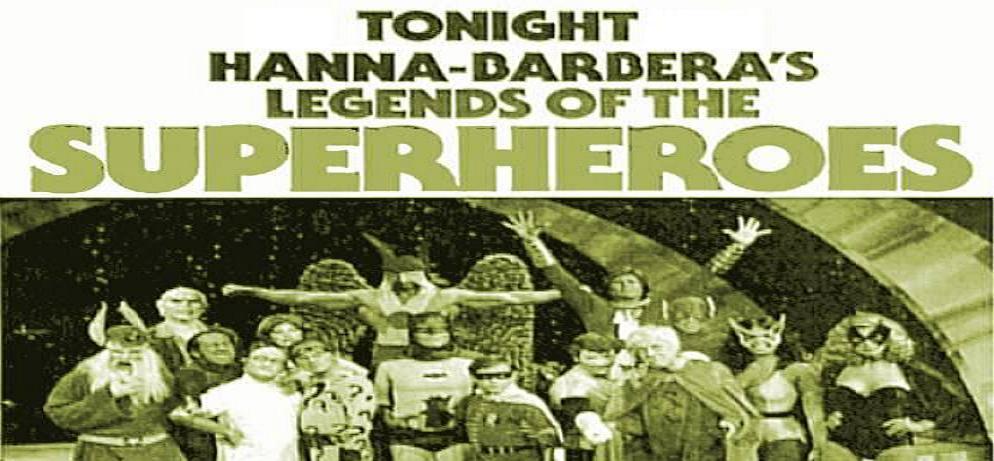Series Retrospective: Legends of the Superheroes
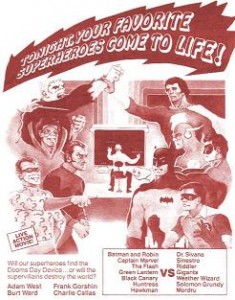 Before we begin this week’s retrospective, please take a moment to review the advertisement to the right of this article. Done? Good, now imagine for a moment that you are twelve year old boy in January of 1979 when this ad was run in TV guides across the country. Like most twelve year old boys of the day, you are infatuated with superheroes, especially the ones you look forward to reading about in comic books each month. It’s a safe bet that upon seeing an advertisement like this one you will be on pins and needles for the days leading up to this broadcast that will surely represent a life changing event for you. It’s a shame that when that eagerly awaited day finally arrives and you stare in breathless anticipation as the program begins, all you have ahead of you is an hour long let down.
Before we begin this week’s retrospective, please take a moment to review the advertisement to the right of this article. Done? Good, now imagine for a moment that you are twelve year old boy in January of 1979 when this ad was run in TV guides across the country. Like most twelve year old boys of the day, you are infatuated with superheroes, especially the ones you look forward to reading about in comic books each month. It’s a safe bet that upon seeing an advertisement like this one you will be on pins and needles for the days leading up to this broadcast that will surely represent a life changing event for you. It’s a shame that when that eagerly awaited day finally arrives and you stare in breathless anticipation as the program begins, all you have ahead of you is an hour long let down.
Hanna-Barbera had a massive hit on their hands when they introduced The Superfriends to the ABC Saturday morning line up in 1973. Sugar fueled children across the country tuned in every week to watch the animated adventures of some of their favorite heroes from the pages of DC comic books. The show was so popular it would be revamped and rerun in various permutations on Saturday mornings for the next thirteen years and in syndication for long afterwards.
In 1978, the show underwent one of its most ambitious and entertaining reworkings. The name was changed to Challenge of the Superfriends, the roster was expanded to include most of the key players from the Justice League of America (plus a few racially beneficial additions created specifically for the series), and the heroes were finally given villains worthy of their attention. The latter were actually an organized group who called themselves the Legion of Doom and operated out of a mobile headquarters that was shaped like the helmet of Darth Vader’s cousin Murray.
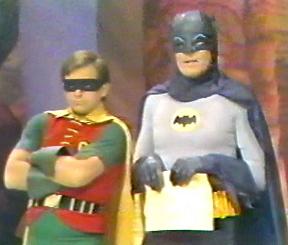
The dynamic duo of Burt Ward and Adam West return!
It quickly became obvious that Challenge was the high point of the Superfriends’ Saturday morning career and it was going to be hard to follow with an encore. Rather than try to improve on these cartoon capers, Hanna-Barbera decided to transfer the concept to live action with a new series that could potentially play prime time television. Thus the groundwork was laid for the abomination that would be known as Legend of the Superheroes.
To the credit of Hanna-Barbera, their casting was top notch. Their major accomplishment was getting Adam West and Burt Ward to return in the Batman and Robin roles they had made famous on television in the 60’s. The remainder of the heroes were played by unknowns but most of their characters were very familiar to comic book and Saturday morning television fans. Flash, Green lantern, and Hawkman were already regulars on the Challenge of the Superfriends cartoon and Captain Marvel had recently wrapped up a three year run in the Filmation television series Shazam! (surprisingly neither of the two actors who played the role on that show were asked to reprise it here). To keep this from being a boys club, Hanna-Barbera tossed in the obvious choice of female Justice League member Black Canary. In a strange move that must have baffled more than one comic book fan like me, the final female member chosen was The Huntress, a member of the Justice Society of America and resident of Earth-2 where she was the daughter of that world’s Batman! Apparently DC must have taken Superman and Wonder Woman off the table since the former had just embarked on a successful film career the year before and the latter still had her own prime time televisions series.
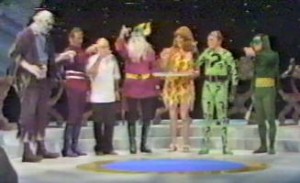
The live action Legion of Doom.
The casting for the villains proved that Hanna-Barbera viewed this series more as a comedy than anything action oriented like its cartoon counterpart. Frank Gorshin returned as The Riddler from the 60’s Batman show and he was joined by some other well known comedians. Rising star Jeff Altman was still a year away from hosting one of the worst variety shows in history, Pink Lady and Jeff, when he signed on as Flash’s nemesis, the Weather Wizard. Charlie Callas was taped to play Green Lantern foe Sinestro and Howard Morris, best remembered as Ernest T. Bass on The Andy Griffith Show, played Captain Marvel’s evil scientist enemy, Dr. Sivana. Buried under a fake beard and blue pancake was ex-Bowery Boy Gabriel Dell playing the wizard Mordru. This was another one of those head scratching decisions by the producers since Mordru was a villain from the future who had often nearly defeated the entire Legion of Superheroes and would never be caught dead in a group like this one in the comic books! Also slightly out of place was the Earth-2 swamp monster Solomon Grundy. This massive zombie like creature had nearly killed Superman in the comics a few years earlier but was shown trading inconsequential blows with Batman here! The final villain, or villainess, was Wonder Woman’s female foe Giganta who had the ability to increase her size in the cartoons but merely retained the super strength of her comic book characterization here.
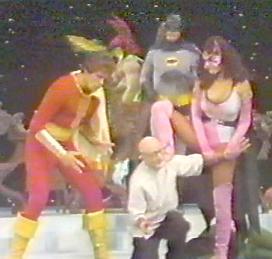
Is this a super battle or a fetish party?
With a strong cast and an interesting selection of heroes and villains, you would think Legend of the Superheroes would be a sure fire hit, unfortunately it was anything but. The first of only two episodes filmed was titled The Challenge and featured the standard plot of the bad guys hiding a doomsday device and the good guys trying to find it. Rather than showcasing any acts of super heroics or deductive sleuthing as a comic book or the Saturday morning series might have done, we get a succession of increasingly lame gags. The villains disguise themselves, thanks to Mordru’s magic (now it makes sense why he’s there), to send the heroes on wild goose chases and keep them from finding the bomb. Since they didn’t have much to go on in the first place it would have probably been more effective just to leave them alone.
Due to the almost nonexistent special effects, we never see Hawkman fly, instead of running at super speed, Flash teleports, and Green Lantern is limited to only firing a green beam from his ring. One of the villains’ schemes involves Dr. Sivana, dressed as a lemonade vendor, tricking the superheroes into drinking a potion that strips them of their super powers. This fails to take into consideration that only two of the heroes have abilities this should affect, Flash and Black Canary. Captain Marvel’s powers are magic based and the other five, like Batman and Robin, either have no extraordinary abilities or rely on technological enhancements. Apparently it was more important to have groan inducing jokes than an accurate story.
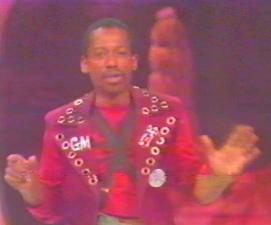
Ghetto Man, a positive urban role model?
While The Challenge was nothing to brag about, the follow up episode, The Roast, makes it look like award winning material. As the title implies, this story revolves around a roast for the superheroes with Tonight Show second banana Ed McMahon as Master of Ceremonies. In addition to the villains from the previous episode that pop in to exchange barbs and make disparaging comments, we also get some not so subtle parodies of celebrities of the day and a few nonsensical characters like Hawkman’s mother! The one inspired moment in the entire hour is also the most politically incorrect. Bit player Brad Sanders appears as an African-American superhero named Ghetto Man who wears a costume of rags adorned with what appear to be car hood ornaments. He does a brief comedy routine that consists of jokes like how the team needs more “colored people” and no, Green Lantern doesn’t count! Some days I miss the 70’s! A set bound story of this type is usually the kind of thing reserved for the end of the season when the budget is already painfully close to depleted but Hanna-Barbera used this ploy as a follow up to the pilot. Considering that this was also the final episode in the series though it does even things out and proves that at least HB had the good sense to pull the show before it had even aired.
While Hanna-Barbara was smart enough to cancel the show only two episodes in, they still insisted on airing both of them. In January of 1979, the episodes were broadcast a week apart and then disappeared into the obscurity they so richly deserved. A few die hard comic book fans insisted on recording these episodes on the brand new medium of video cassette tape, presumably to remind future generations of just how badly a good idea can go wrong. Hanna-Barbera went back to the cartoons they did best and young superhero fans like myself went to school the next day feeling let down and betrayed!
